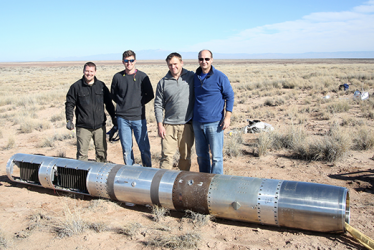Special to UM News
 Massimiliano Galeazzi, associate chair and professor of physics at the College of Arts and Sciences, was part of a team that was awarded the Robert H. Goddard (RHG) Exceptional Achievement for Science Award by NASA.
Massimiliano Galeazzi, associate chair and professor of physics at the College of Arts and Sciences, was part of a team that was awarded the Robert H. Goddard (RHG) Exceptional Achievement for Science Award by NASA.
The RHG award recognized the successful development of an instrument called the sheath transport observer for redistribution mass, or STORM. The detector was designed to study the X-ray glow and captures images from our solar system and its surroundings; it’s the first X-ray imager using micro-porous optics successfully launched into space.
“We were very happy to be recognized for the effort and work that went into developing the instrument,” said Galeazzi. “It also recognizes the nice collaboration between the members of different fields and groups.”
The STORM instrument was developed at Goddard Space Flight Center and flew attached to the UM Diffuse X-ray from the Local Galaxy (DXL) rocket, a mission lead by Galeazzi. In addition to the breakthrough discoveries found in the solar system and its surroundings, the DXL mission demonstrated the successful operation of the STORM instrument in space, in particular its innovative micro-porous (or lobster-eye) optics.
“The entire DXL mission led by Professor Galeazzi, which hosted STORM, was the result of phenomenal teamwork between the UM faculty and students, and the NASA field center,” says F. Scott Porter, an astrophysicist at the Goddard Space Center.
The collaboration began nearly four years ago when NASA scientists were looking for a rocket that could carry the STORM instrument in space. The heliophysics and astrophysics divisions of NASA joined forces to accomplish this task, with Galeazzi offering his services as part of the STORM team.
“The successes of the DXL mission and the STORM instrument were built upon collaborative multi-institutional work, with the participation of planetary, astrophysics, and heliophysics scientists,” said David Sibeck, a heliophysicists at the Goddard Space Center. “They point the way toward a future in which cost-effective university and NASA partnerships hone in on the most pressing research problems facing space scientists.”
Galeazzi worked as a scientist at NASA’s Goddard Space Flight Center in Greenbelt, Maryland before joining the UM College of Arts and Sciences in 2002. Since then, he continues to collaborate with NASA in constructing devices that can detect X-ray emissions in space.








